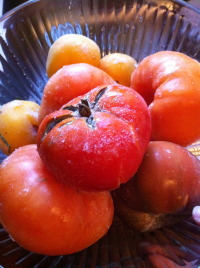 A few months later….
A few months later….
Coming back from a long break, and it feels like I owe an explanation. I don’t have one. Somehow I just stopped writing, and I don’t really know why. Lots of things happened to distract me: a giant garden, feeling lousy and then getting better, settling into a new farm and home. I could have been writing all the way through, but didn’t. Maybe I needed to nourish my introvert. Maybe I was feeling “off my game” and didn’t know what to say. Maybe I took on too much, and I was just pushing through. Maybe it was a bit of all of these things. And I don’t know why I suddenly felt like writing this morning. Maybe it’s because I’ve had a month of down-time. Maybe it’s because I just started participating in a fabulous writing group. Maybe it’s because I recently quit Facebook, and I want to stay in contact with you all. So many "maybes." Here's what I know: I’m happy to be back.
I am enjoying the fruits of the summer, with snow now outside my window. I love this about farming—the opportunity to preserve and enjoy the harvest the whole year through. Right now I have a big bag of tomatoes defrosting on my counter, which I’ll turn into sauce or soup. Most every day I have a bit of homemade sauerkraut from this summer’s bumper crop of cabbage. Yesterday, I added some roasted sweet peppers to my eggs for breakfast, and then had some green beans with my dinner. And I’m eyeing that container of Baingan Bhartha (Indian-spiced eggplant), prepared back in September, for tomorrow’s lunch. Those summer flavors just stretch on and on.
About those frozen tomatoes: Most people blanch their tomatoes and can them. Canning is smart, because you can keep that food on your shelf, and use it even when the power goes out. But canning also destroys about 50% of the nutrients of the vegetable. Canning also takes up precious time during the height of harvest, and uses a good deal of energy.
 When I was bringing in wheelbarrows full of tomatoes this summer, there was no way for me to process them all (i.e. dry them, can them, or make sauce and freeze it). The garden demanded all my time, and so, after some research, I decided just to freeze them whole. Frozen whole, tomatoes keep their wonderful flavor. But freezing them whole only works if you’re going to turn them into sauce or soup; freezing ruins their texture, and after thawing they are like canned tomatoes.
When I was bringing in wheelbarrows full of tomatoes this summer, there was no way for me to process them all (i.e. dry them, can them, or make sauce and freeze it). The garden demanded all my time, and so, after some research, I decided just to freeze them whole. Frozen whole, tomatoes keep their wonderful flavor. But freezing them whole only works if you’re going to turn them into sauce or soup; freezing ruins their texture, and after thawing they are like canned tomatoes.
Like everything, there’s pros and cons to freezing tomatoes whole—pro: you don’t have to process them during the great deluge known as “harvest season.” Pro: once defrosted, you need only use a little energy to cook them. Con: you have to think ahead when you want sauce, and let the tomatoes defrost overnight. Con: you have to hope and pray that the electricity doesn’t go down, and spoil the contents of your freezer! But in this very mild winter, we’ve not even lost the electricity once, and all our goods are still happily preserved.
But what I love about freezing them whole is that when they defrost, they lose most of their water, which reduces cooking time immeasurably and conserves energy. I let them thaw overnight, and when they are completely thawed, they’ll be sitting in a big pool of water. When I’m making sauce, I toss that water, and then sauté up some onions in butter. While the onions are turning translucent, I quickly peel the skin off the tomatoes and pinch the stem core out. When the onions are done, I throw the tomatoes in with some salt and ground black pepper, and simmer for about 10 minutes. This quick sauce tastes heavenly: fresh, light, sweet and just acidic enough. A bit of summer, in January. A bit of perspective on the whole year.
And now during these quieter days, I’m thinking again about garden design, crop varieties, seed quantities. Part of me wants to turn back the clock a month or so, and rest up all over again. But the part of me that is relishing those summer flavors is also dreaming up next year’s palate…
The challenge will be to dream up a smaller garden, one that’s more manageable for one intern and me. I took on too much last year—it was doable, but just. This year I want to integrate more perennial plants into the garden, and use more permacultural techniques for building soil, improving water retention, and controlling pests. I have a lot of ideas…
But I also have just a few weeks of “dreamtime” left; we begin starting seeds at the end of February. Then it will be time to prune trees, set up the greenhouse, start sheet mulching. So while there is still time for napping and sleeping late, and time for reading books in the bath, let me get to it.